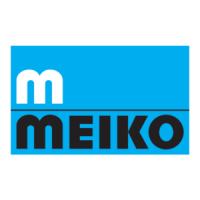Why is the emergency program active on my Meiko DV 200.2 PW?
- TTanya WilliamsSep 8, 2025
The emergency program on your Meiko Dishwasher may be active, restricting washing, because there is no boiler or tank heating. Check the system to resolve this.

Why is the emergency program active on my Meiko DV 200.2 PW?
The emergency program on your Meiko Dishwasher may be active, restricting washing, because there is no boiler or tank heating. Check the system to resolve this.
Why does my Meiko Dishwasher say maintenance required?
The Meiko Dishwasher indicates maintenance is required when the set operating hours or batch number has been reached. To resolve this, inform the service department and perform maintenance. Afterward, reset the maintenance counter.
What to do if Meiko Dishwasher says refill with salt?
If your Meiko Dishwasher indicates 'Refill with salt', it means there is no brine available. Check the salt supply and ensure there is water in the salt solution reservoir. Also, check if the float switch S5 is working.
What to do if Meiko DV 200.2 PW shows error in the dosing system ADT?
If you see an error in the ADT dosing system of your Meiko Dishwasher, it indicates that the flow meter is recognizing impulses even when detergent dosing is not in progress. This can happen if the valve of the dosing unit is not closing. In that case, you should check the valve of the dosing unit.
| Basket size | 500 x 500 mm |
|---|---|
| Clearance height | 440 mm |
| Number of programs | 3 |
| Delay start | No |
| Child lock | No |
| Wash cycle time | 120 min |
| Water consumption | 2.6 liters per cycle |
Ensuring safe machine operation through operator diligence and adherence to measures.
Dangers from electric current, moving parts, and improper use.
Safety measures for electrical equipment and panel installation.
Specifies minimum/maximum pressure, water stop, and particle protection.
Steps to switch off the machine using the 'Off' key and drain the tank.
Steps for cleaning the tank, wash arms, and nozzles.
Procedure for de-scaling and safety precautions for residues.
Guides on troubleshooting common faults like no filling, poor spray, and foam.
Steps to enter code entry mode and navigate programming levels.
How to access and navigate service parameters (1xx).
How to view the status of machine inputs (set or not set).
Explanation of information displays and common error codes (e.g., 120, 121, 122).
Details of information codes (324, 420, 520, etc.) and their possible causes.
Causes for errors related to filling levels and temperature increases.
